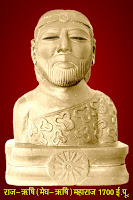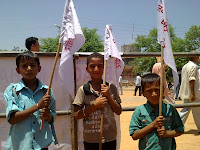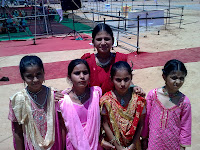विकिलीक्स (Wikileaks) ने भारतीय समाज में विद्यमान जाति प्रथा को छुआ है. इस बारे में एक लिंक मिला है जिसे आपके साथ साझा कर रहा हूँ.
http://atrocitynews.wordpress.com/2011/03/25/wikileaks-exposes-caste-virus-in-indian-life/
Other links from this blog

विकिलीक्स (Wikileaks) ने भारतीय समाज में विद्यमान जाति प्रथा को छुआ है. इस बारे में एक लिंक मिला है जिसे आपके साथ साझा कर रहा हूँ.
http://atrocitynews.wordpress.com/2011/03/25/wikileaks-exposes-caste-virus-in-indian-life/
Other links from this blog
Other links from this blog
Thanks & Regards,
Yours
Navin K. Bhoiya
Other links from this blog
This post was very big in size and needed to be shifted. It has been archived at the link given below:-
Scheduled Castes’ as a Separate Religious Identity
Comments can be given on the link given above. Sorry for inconvenience.
Other links from this blog
कुछ समय पहले एक पोस्ट में मैंने कच्छ, गुजरात से शुरू समाचार-पत्र ‘मेघधारा’का उल्लेख किया था. इसे देखने की इच्छा बड़ी देर से थी. कुछ सप्ताह पहले श्री नवीन भोइया ने मुझे पत्रिका की पीडीएफ़ फाइलें भेजीं.
 |
| This image is becoming new symbol of aboriginals (Mulnivasis) of Indus Valley Civilization |
See this link. Horses were brought by Aryans to Indus Valley region:
Other links from this blog
(अमृत नमन, रविवार, 6 मार्च, 2011 को 5:29 बजे.)
‘Meghvansh Ek Singhavlokan’ is a fascinating book written by Mr. R.P. Singh an I.P.S. officer (of IG rank) from Rajasthan cadre. It has been written in Hindi with Rajasthani flavor. The writer carries a literary background. The book contains cultural, mythical and historical material on Meghvansh. The first edition of the book got into controversy over a few idiomatic comments and there was agitation against the book and the writer. Traditionalists opposed few expressions in it and as usual the matter was taken to the press and many more forums. The present edition is revised and improved one.
मेघवंश एक सिंहावलोकन
मेघवंश एक सिंहावलोकन का सार
 |
| It was scorching sun on the head – hands held banners of ‘Jai Kabir’ सिर पर थी धूप – और हाथों में जय कबीर के झंडे |
 |
| These little girls took the sun on their cheeks इन्होंने तो धूप को गालों पर लिया |
 |
| Children remembered to smile in front of camera. कड़ी धूप मे ये बच्चे कैमरा के सामने मुस्कराना नहीं भूले |
Caste does not only operate along fault lines between the higher and lower caste. It equally afflicts the Scheduled Castes from within. The Scheduled Castes are as much divided among themselves as the other various twice born castes. The similar situation applies to the Other Backward Castes (OBC) too. Baba Sahib Dr. B.R. Ambedkar highlighted this aspect of the caste system in many of his speeches and writings. He was of the opinion that Scheduled castes were as much divided house within as the division between them and rest of the twice born. Irrespective of the fact that they were socially excluded and relegated out of the boundaries of the suffocating caste hierarchy emanated from the Varna system, the Scheduled Caste themselves follow the same logic of social exclusion and discrimination on the pattern of Brahminical graded inequality. Baba Sahib Dr. Ambedkar reiterated that if the Scheduled Castes wanted to get rid of the social exclusion and untouchability, they have to say first good bye to the social evil of untouchability within. Unless and until the internal social division is not taken care of, the requisite unity among the various Dalit castes is difficult to evolve. Unity among the various communities among the Scheduled Castes is the most necessary requirement for any democratic Dalit movement to come forward to take cudgels with the Brahminical Social Order (BSO).
In Punjab at present there are as many as 39 castes among the Scheduled Castes. In the 2001 Census their number was 38. Later on in 2007, another caste of Rai Sikhs was added to the list of Scheduled Caste in Punjab, thus making the figure thirty nine. Scheduled Castes in Punjab like their counterparts in rest of India are not only divided along caste lines, they are equally splintered into various religions. Scheduled Castes in Punjab are Hindus, Sikhs, Christians and Buddhists. Some of them claim to be belonging to their indigenous religion Ad Dharm; though after 1931 census Ad Dharm did not figure in the decennial census of India. The 39 Scheduled Castes of Punjab have their peculiar social hierarchical system whereby they have causally arranged themselves on low-high profile parallel to the prevalent Brahminical caste system in the rest of the country. It was against this social division within that Babu Mangu Ram Mugowalia, the founder of the famous Ad Dharm movement, addressed almost all the then caste members of the ex-untouchables by their specific caste names to come forward on a single platform forgetting their insidious caste factor and fight collectively the monster of untouchability.
Where are we standing today? Are we not a divided house? Take for example marriages. There is hardly any inter-caste marriage within the Scheduled Castes. Ad Dharmi will prefer to marry within the Ad Dharmi caste. In the matrimonial advertisements it is common to find that marriage alliances are sought strictly within castes. One hardly finds marriages between the Chamar and Balmiki castes. Buddhists Dalits like all other Dalits belonging to different religions equally follow the criterion of caste endogamy in the marriages. All this has prevented unity among the Scheduled Castes. Probably this may be one of the most important reasons behind the failure of the Scheduled Caste in Punjab to come into political power despite their large numbers. Let us think beyond caste and forge a strong unity to empower ourselves.
Posted on January 1, 2011
“LOOKING WITHIN: DALIT MOVEMENT AT THE CROSSROADS”
Other links from this blog